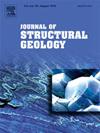Partitioning of strain rates and stresses between a thin shear zone and its walls under transpression or transtension
IF 2.9
2区 地球科学
Q2 GEOSCIENCES, MULTIDISCIPLINARY
引用次数: 0
Abstract
Within a mid-crustal domain deforming in transpression or transtension, thin zones may exhibit higher strain than their immediately adjacent walls. The lower transpressive strain of the host may sometimes not be recognized and these thin bands might thus be interpreted as simple shear zones. However, their kinematic indicators should reflect the transpressional or transtensional strain imposed by the less deformed host. In order to explore the contrasting strain between such a zone and its walls, we analyse a simple model of a narrow low-viscosity oblique transcurrent shear zone held coherently within a broader, higher-viscosity host rock. The model uses strain rate as a proxy for strain.
We evaluate the contrasts in strain rate intensities and in shape parameters between such a shear zone and its walls as functions of viscosity contrast and of convergence angles. We find important differences between transpressional or transtensional shear zones and the more familiar simple shear zones.
Strain fabrics observed in some crustal scale shear zones and their walls, such as the Archean Larder Lake-Cadillac Deformation Zone (LCDZ) in Ontario and Québec, Canada, which combine transcurrent shear sense indicators and steeply plunging lineations, can indeed be explained by transpression.
We also examine the contrast in stresses between the shear zone and its walls. We find that, in transpression, buoyant fluids that might be generated in the deep crust, near the base of a deformation zone such as the LCDZ, should in fact move through the wall rock rather than within that high-deformation zone. This has implications for the location of mineral deposits traditionally associated with such deformation zones.
受压或受拉作用的薄剪切带及其壁面之间的应变率和应力的分配
在挤压变形或拉伸变形的中地壳域中,薄带的应变可能比其直接相邻的壁面要高。宿主的下压应变有时可能无法识别,因此这些薄带可能被解释为简单的剪切带。然而,它们的运动学指标应该反映变形较小的宿主施加的跨扭或跨拉应变。为了探索这样一个带与其壁面之间的对比应变,我们分析了一个简单的模型,即一个狭窄的低粘度斜斜横流剪切带在一个更宽、更高粘度的宿主岩石中保持一致。该模型使用应变率作为应变的代理。我们评价了这种剪切带及其壁面之间的应变率强度和形状参数的差异,作为粘度对比和收敛角的函数。我们发现跨扭或张拉剪切带与更熟悉的简单剪切带之间有重要的区别。在一些地壳尺度剪切带及其壁面中观测到的应变组构,如安大略省和加拿大quacmebec的太古代Larder湖- cadillac变形带(LCDZ),结合了横向剪切感指标和陡降线,确实可以用挤压作用来解释。我们也检查在剪切区和它的墙之间的应力对比。我们发现,在挤压作用中,在靠近LCDZ等变形带底部的地壳深处可能产生的浮力流体实际上应该穿过围岩,而不是在高变形带内移动。这对传统上与这种变形带有关的矿藏的位置有影响。
本文章由计算机程序翻译,如有差异,请以英文原文为准。
求助全文
约1分钟内获得全文
求助全文
来源期刊

Journal of Structural Geology
地学-地球科学综合
CiteScore
6.00
自引率
19.40%
发文量
192
审稿时长
15.7 weeks
期刊介绍:
The Journal of Structural Geology publishes process-oriented investigations about structural geology using appropriate combinations of analog and digital field data, seismic reflection data, satellite-derived data, geometric analysis, kinematic analysis, laboratory experiments, computer visualizations, and analogue or numerical modelling on all scales. Contributions are encouraged to draw perspectives from rheology, rock mechanics, geophysics,metamorphism, sedimentology, petroleum geology, economic geology, geodynamics, planetary geology, tectonics and neotectonics to provide a more powerful understanding of deformation processes and systems. Given the visual nature of the discipline, supplementary materials that portray the data and analysis in 3-D or quasi 3-D manners, including the use of videos, and/or graphical abstracts can significantly strengthen the impact of contributions.
 求助内容:
求助内容: 应助结果提醒方式:
应助结果提醒方式:


